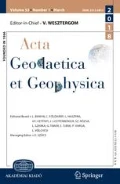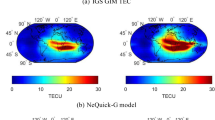Abstract
Ionospheric peak electron density (NmF2) and total electron content (TEC) are the essential measures of ionospheric variability for modeling their effects on navigation and communication system applications. The global and regional models have their limitations in predicting ionospheric variations at the low latitude Indian region, mainly due to the anomalous electron density gradients and equatorial ionization anomaly (EIA) effects. In this paper, ionospheric TEC characteristics are modeled based on canonical correlation analysis (CCA) with Global Positioning System (GPS)-TEC observations and NmF2 values at a northern low latitude station Bangalore (13.02° N and 77.57° E) during the 2017 period. The decomposed CCA modes consist of CCA patterns and their corresponding amplitudes. The short-term variations (diurnal) are reproduced by the CCA patterns, whereas the long-term variations (yearly) are reproduced by their corresponding amplitudes. The first three CCA modes represent the ionospheric features such as diurnal, sunrise and sunset enhancements, semiannual, annual, and solar-cycle variations. Further, the temporal structures of NmF2 are effectively replicated by the CCA model. NmF2 (CCA) showed relatively higher linearity (0.99) and lower RMSE (0.31 TECU), whereas NmF2 (IRI2016) showed lower linearity (0.92) and higher RMSE (1.45 TECU) with the measured-NmF2 values. Hence, the CCA approach could be an effective method for characterizing the NmF2 variations over the low latitude region.







Similar content being viewed by others
References
Amerian Y, Hossainali MM, Voosoghi B (2013a) Regional improvement of IRI extracted ionospheric electron density by compactly supported base functions using GPS observations. J Atmos Sol Terr Phys 92:23–30
Amerian Y, Voosoghi B, Hossainali MM (2013b) Regional ionosphere modeling in support of IRI and wavelet using GPS observations. Acta Geophys 61:1246–1261
Ansari K, Park K-D, Panda SK (2019) Empirical orthogonal function analysis and modeling of ionospheric TEC over South Korean region. Acta Astronaut 161:313–324. https://doi.org/10.1016/j.actaastro.2019.05.044
Ansari K, Panda SK, Jamjareegulgarn P (2020) Singular spectrum analysis of GPS derived ionospheric TEC variations over Nepal during the low solar activity period. Acta Astronaut 169:216–223
Bilitza D, Altadill D, Truhlik V, Shubin V, Galkin I, Reinisch B, Huang X (2017) International reference ionosphere 2016. From ionospheric climate to real-time weather predictions. Space Weather 15:418–429
Cander LR (2019) Ionospheric space weather. Springer, Berlin
Dabbakuti JRKK, Ch B (2019) Ionospheric monitoring system based on the Internet of Things with ThingSpeak. Astrophys Space Sci 364:137
Dabbakuti JK, Ratnam DV (2016) Characterization of ionospheric variability in TEC using EOF and wavelets over low-latitude GNSS stations. Adv Space Res 57:2427–2443
Dabbakuti JK, Ratnam DV (2017) Modeling and analysis of GPS-TEC low latitude climatology during the 24th solar cycle using empirical orthogonal functions. Adv Space Res 60:1751–1764
Dabbakuti JK, Mallika Y, Rao MV, Rao KR, Ratnam DV (2019) Modeling of GPS-TEC using QR-decomposition over the low latitude sector during disturbed geomagnetic conditions. Adv Space Res 64:2088–2103
Dashora N, Suresh S (2015) Characteristics of low-latitude TEC during solar cycles 23 and 24 using global ionospheric maps (GIMs) over Indian sector. J Geophys Res Space Phys 120:5176–5193
Goodman JM (1992) HF communication: science & technology. Van Nostrand Reinhold Company, New York
Gopi S (2010) Rinex GPS-TEC program, version 1.45. Boston College, Newton
Gulyaeva T (1997) TEC residual slab-thickness between bottomside and topside ionosphere. Acta Geod Geophys Hung 32:355–363
Gulyaeva T (2003) International standard model of the Earth’s inosphere and plasmasphere. Astron Astrophys Trans 22:639–643
Hotelling H (1992) Relations between two sets of variates. Breakthroughs in statistics. Springer, Berlin, pp 162–190
Houminer Z, Soicher H (1996) Improved short-term predictions of ƒ0F2 using GPS time delay measurements. Radio Sci 31:1099–1108
Jamjareegulgarn P, Ansari K, Ameer A (2020) Empirical orthogonal function modelling of total electron content over Nepal and comparison with global ionospheric models. Acta Astronaut 177:497–507. https://doi.org/10.1016/j.actaastro.2020.07.038
Kaplan ED, Hegarty C (2017) Understanding GPS/GNSS: principles and applications. Artech House, Norwood
Karanam S, Ratnam DV, Dabbakuti JK (2019) Ionospheric time delay corrections based on the extended single layer model over low latitude region. Geod Geodyn 10:235–240
Li S, Li L, Peng J (2016) Variability of ionospheric TEC and the performance of the IRI-2012 model at the BJFS station. China Acta Geophys 64:1970–1987
Liu L, Wan W, Zhang ML, Zhao B, Ning B (2008) Prestorm enhancements in NmF2 and total electron content at low latitudes. J Geophys Res Space Phys 113:A02311
Neeli R, Dabbakuti JK, Chowdhary VR, Tripathi NK, Devanaboyina VR (2018) Modeling of local ionospheric time varying characteristics based on singular value decomposition over low-latitude GPS stations. Astrophys Space Sci 363:182
Ratnam DV, Dabbakuti JK, Sunda S (2017) Modeling of ionospheric time delays based on a multishell spherical harmonics function approach. IEEE J Sel Top Appl Earth Obs Remote Sens 10:5784–5790
Ratnam DV, Dabbakuti JK, Lakshmi NS (2018) Improvement of Indian-regional Klobuchar ionospheric model parameters for single-frequency GNSS users. IEEE Geosci Remote Sens Lett 15:971–975
Ratnam DV, Otsuka Y, Sivavaraprasad G, Dabbakuti JRKK (2019) Development of multivariate ionospheric TEC forecasting algorithm using linear time series model and ARMA over low-latitude GNSS station. Adv Space Res 63:2848–2856
Razin MRG, Voosoghi B (2016) Modeling of ionosphere time series using wavelet neural networks (case study: NW of Iran). Adv Space Res 58:74–83
Reddybattula KD, Panda SK (2019) Performance analysis of quiet and disturbed time ionospheric TEC responses from GPS-based observations, IGS-GIM, IRI-2016 and SPIM/IRI-Plas 2017 models over the low latitude Indian region. Adv Space Res 64:2026–2045
Singh S, Rathore V, Singh AK, Singh A (2017) Ionospheric irregularities at low latitude using VHF scintillations during extreme low solar activity period (2008–2010). Acta Geod Geophys 52:35–51
Soicher H, Houminer Z (1998) Determination of f 0 F2 short-term variations from GPS time delay observations. Acta Geod Geophys Hung 33:111–119
Sridhar K, Sridhar M, Raghunath S, Ratnam DV (2020) Ionospheric anomaly detection and Indian ionospheric climatology from GAGAN receivers. Acta Geod Geophys. https://doi.org/10.1007/s40328-020-00290-9
Suraj PS, Dabbakuti JK, Chowdhary VR, Tripathi NK, Ratnam DV (2017) Linear time series modeling of GPS-derived TEC observations over the Indo-Thailand region. J Geod 92:863–872
Venkatesh K, Rama Rao P, Prasad D, Niranjan K, Saranya P (2011) Study of TEC, slab-thickness and neutral temperature of the thermosphere in the Indian low latitude sector. Ann. Geophys. 29:1635–1645
Von Storch H, Zwiers FW (2001) Statistical analysis in climate research. Cambridge University Press, Cambridge
Wan W, Liu L, Ning B (2008) Modeling the global ionospheric TEC with statistical eigen mode analysis. In: 37th COSPAR scientific assembly, p 3385
Wilks DS (2011) Statistical methods in the atmospheric sciences, vol 100. Academic Press, Cambridge
Xue X-h, Wan W-x, Xiong J-g, Dou X-k (2008) The characteristics of the semi-diurnal tides in mesosphere/low-thermosphere (MLT) during 2002 at Wuhan (30.6° N, 114.4° E)—using canonical correlation analysis technique. Adv Space Res 41:1415–1422
Yu Y et al (2013) Modeling the global NmF2 from the GNSS-derived TEC-GIMs. Space Weather 11:272–283
Author information
Authors and Affiliations
Corresponding author
Rights and permissions
About this article
Cite this article
Pyla, R.K., Dabbakuti, J.R.K.K., Mutchakayala, S.G.P. et al. Modeling of ionospheric characteristics based on canonical correlation analysis at Bangalore for the year 2017. Acta Geod Geophys 55, 579–592 (2020). https://doi.org/10.1007/s40328-020-00317-1
Received:
Accepted:
Published:
Issue Date:
DOI: https://doi.org/10.1007/s40328-020-00317-1




